Inpatient census 2018: parts one and two
Results of the fourth Mental Health & Learning Disability Inpatient Census and Out of Scotland NHS Placements Census, 2018.
This document is part of a collection
4. Additional Analysis: Patients receiving Forensic Services
- 475 (14%) patients in the Census were receiving Forensic Services
- Patients receiving Forensic Services are mostly males of working age
- 81% of forensic patients were either Overweight or Obese as at the Census
Forensic psychiatry is a specialised branch of clinical psychiatry which relates to mentally disordered offenders and others with similar problems. For the purpose of the analysis contained in this section, forensic patients were identified if NHS Boards indicated "yes"
to the following Census question: is the patient being managed primarily by forensic services?
There were 475 patients primarily managed by Forensic Services in the 2018 Census. This is a decrease on the 484 patients reported in 2017.
It should be noted that NHS Greater Glasgow & Clyde, NHS Lothian and NHS Tayside contain Forensic Regional Units which provide services to patients from other NHS Boards. NHS Fife also provide a low secure Learning Disability (Forensic) Regional Unit for the treatment of patients from other NHS boards. The State Hospital (a Special NHS Board), provides a National Service (including for Northern Ireland).
Table 12: Number of patients, by NHS Board and Census, forensic services
| NHS Board of Treatment | 2014 Census | 2016 Census | 2017 Census | 2018 Census |
|---|---|---|---|---|
| NHS Ayrshire & Arran | * | * | 16 | 18 |
| NHS Borders | 0 | * | 0 | 0 |
| NHS Dumfries & Galloway | 0 | * | 0 | * |
| NHS Fife | 31 | 34 | 39 | 35 |
| NHS Forth Valley | 20 | * | * | * |
| NHS Grampian | 42 | 42 | 40 | 41 |
| NHS Greater Glasgow & Clyde | 128 | 122 | 119 | 123 |
| NHS Highland | * | * | * | * |
| NHS Lanarkshire | 19 | 15 | 20 | 25 |
| NHS Lothian | 65 | 47 | 56 | 51 |
| NHS Tayside | 65 | 55 | 64 | 62 |
| NHS Western Isles | 0 | 0 | 0 | 0 |
| State Hospital | 121 | 117 | 111 | 108 |
| Scotland | 507 | 458 | 484 | 475 |
* Suppressed due to small numbers
Age and Gender
The majority of patients receiving forensic services are working age males. Male patients made up 93% of all forensic services patients in the 2018 Census, similar to previous years. Of the females in forensic services, almost all were aged between 18 - 64.
Figure 21: Proportion of patients, tree map, age and gender, 2018 Census, forensic services
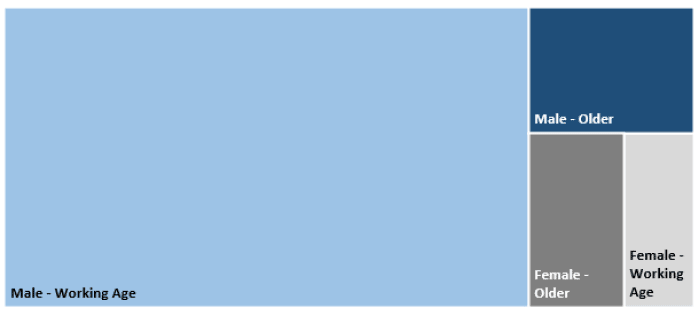
Ward Type
Most patients receiving forensic services were treated in a forensic ward, 429 (90%) patients. Of these, 66 were in a learning disability ward. A further 18 (4%) patients were in an intensive psychiatric care unit.
Figure 22: Number of patients, by ward type, 2018 Census, forensic services
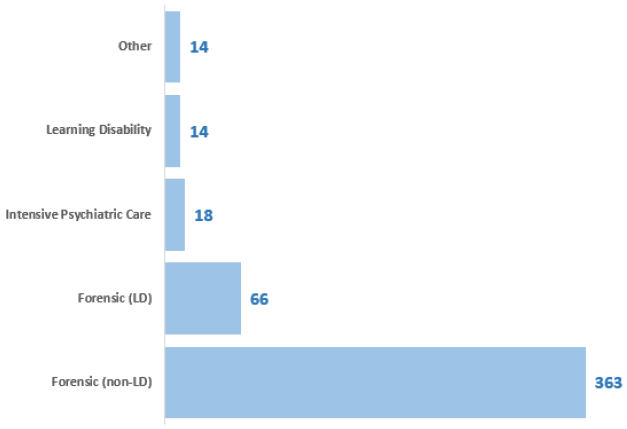
* Other includes wards where numbers were too small to present alone
Ward Security Level
There were 154 (32%) patients receiving forensic services in a low security ward in the 2018 Census. A further 131 (28%) were in a medium security ward, while 108 (23%) were in a high security ward. Only 5% were in a general psychiatric ward, compared with 73% in all mental health, addiction or learning disability patients.
Figure 23: Number of patients, by ward security level, 2018 Census, forensic services
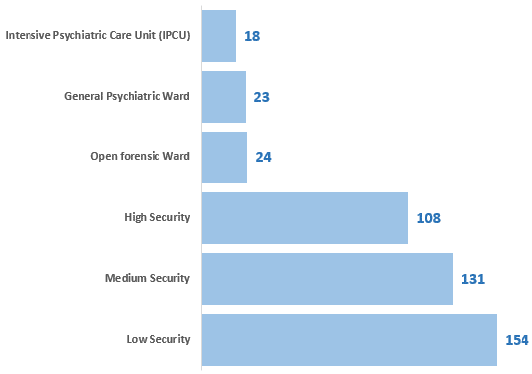
* Some data has been excluded due to small numbers
Specialty of Consultant
A total of 450 patients receiving forensic services were seen by a forensic psychiatrist. This is 95% of forensic services patients for whom this information was returned. There were 14 (3%) patients being seen by a consultant whose specialty was learning disabilities, while the remaining 11 (2%) patients were seen by a consultant whose specialty was general psychiatry.
Length of stay in hospital
Of the 475 patients receiving forensic services in the 2018 Census, 340 (72%) had been in hospital for over a year. Only 13 (3%) patients had been in hospital for less than two weeks.
Table 13: Number of days since admission, by Census, forensic services
| Days since admission | 2016 Census | 2017 Census | 2018 Census | |||
|---|---|---|---|---|---|---|
| Less than 2 weeks | 10 | 2% | 13 | 3% | 13 | 3% |
| At least 2 weeks, less than 1 month | 10 | 2% | 15 | 3% | * | * |
| At least 1 month, less than 3 months | 23 | 5% | 36 | 7% | * | * |
| At least 3 months, less than 6 months | 49 | 11% | 34 | 7% | 43 | 9% |
| At least 6 months, less than 1 year | 45 | 10% | 58 | 12% | 43 | 9% |
| At least 1 year, less than 5 years | 202 | 44% | 203 | 42% | 226 | 48% |
| 5 years or more | 119 | 26% | 125 | 26% | 114 | 24% |
* Suppressed due to small numbers
The average (median) time since admission at the 2018 Census for patients receiving forensic services was just over two years. This compares with non-forensic services patients who had an average (median) admission time of around three months. The higher length of stay for forensic services patients will be influenced by the high number of medium and high security ward patients.
Table 14: Average (median) number of days since admission, 2018 Census
| Group | Average (median) number of days since admission | Approx. number of years / months |
|---|---|---|
| Forensic Services Patients | 763 | 2 years, 1 month |
| Non-forensic Services Patients | 101 | 3 months |
Observation level
All patients in mental health inpatient settings will receive some degree of observation. However, levels of observation will vary according to the patients' individual needs. Based on current guidelines the level of observation of patients at the time of the Census was recorded. Observation level definitions were described on page 13.
Most patients receiving forensic services (91%) fall under general observation, while 29 (6%) were under constant observation. A further 12 (3%) of patients were under special or enhanced observation.
Figure 24: Number of patients, by observation level, 2018 Census, forensic services
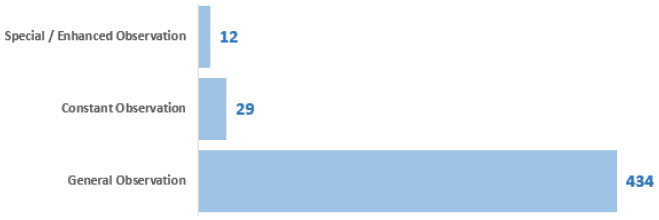
The most common reason for being under constant, special or enhanced observation was risk of self-harm (56%), followed by risk of harm to others (32%).
Health and Wellbeing
Mental health morbidities
NHS Boards returned diagnosis codes (ICD 10) for any mental health condition for which patients in the 2018 Census had a diagnosis. Of the 468 patients receiving forensic services for which diagnosis information was returned, 174 (37%) had 2 or more mental health conditions, this compares to 22% for all adult patients.
Figure 25: Number of patients, by number of mental health conditions, 2018 Census, forensic services
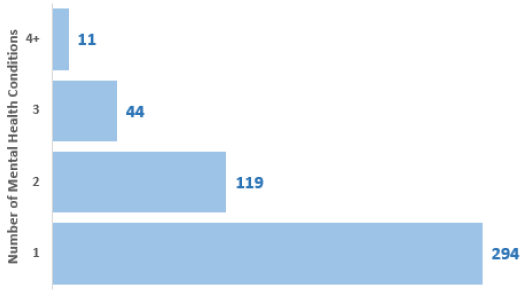
The most common condition for patients receiving forensic services was schizophrenia, with 302 (64%) patients having this condition. This is higher than the 27% reported as being diagnosed with schizophrenia in the all adult population. The second most prevalent condition was personality disorder, accounting for 24% of forensic services patients.
Figure 26: Number of patients, by selected mental health condition, 2018 Census, forensic services
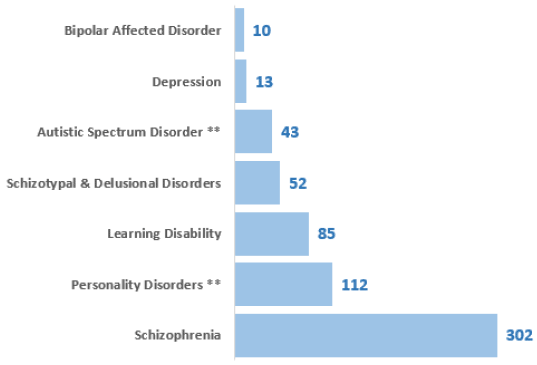
* All mental health diagnoses are based on ICD 10 codes. Primary and secondary diagnoses included.
** Personality disorders and autistic spectrum disorder counts also rely on respective questions on these disorders.
*** Patients may have more than one diagnosis.
Physical health co-morbidities
A total of 255 (54%) patients receiving forensic services had at least one physical health co-morbidity based on the suite of Yes/No physical health questions (see page 22) as at the 2018 Census. This is higher than the 45% reported in 2017 and 41% reported in 2016. It also represents the first time that more forensic patients had a physical health condition than those that did not. The figure is lower than the 60% reported for all adult patients, though forensic patients tend to be younger which may account for this.
Figure 27: Number of patients, , by number of physical conditions, 2018 Census, forensic services
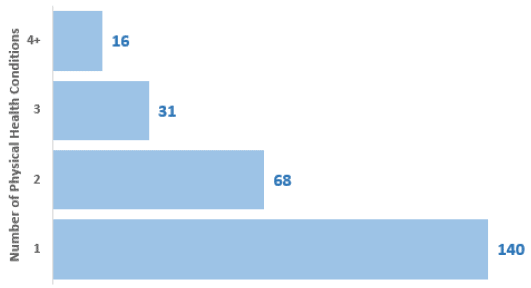
Figure 28 shows a breakdown of the number of patients receiving forensic services for selected physical conditions. The most common condition was diabetes with a total of 70 (15%) forensic services patients having this condition. The second most prevalent was dyslipidaemia, with 13% of patients having this condition. The majority of the 60 patients with dyslipidaemia are currently on treatment for this condition.
Figure 28: Number of patients, by selected physical conditions, 2018 Census, forensic services
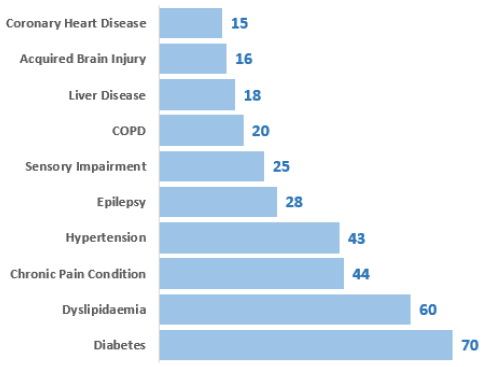
* Patients may have more than one condition
Physical Health Check
There were 135 patients receiving forensic services who were admitted within the last year. Of these, 127 (94%) had a general physical examination within a day of admission. This is similar to the 93% reported for all adult patients and represents a 15 percentage point increase on 2017.
There were 340 patients receiving forensic services who were admitted over one year ago, though information on an annual physical health check was only returned for 333 patients. Of these, 305 (92%) received a physical health check within the last year. This is similar to the 91% reported for all adult patients and represents a 8 percentage point increase on 2017. A further 18 (5%) were offered but declined.
Overall in the 2018 Census, a total of 432 (91%) of patients received some form of physical health check, similar to the 92% reported for all adult patients.
Lifestyle factors
BMI (Body Mass Index)
BMI (Body Mass Index) was calculated for patients whom height and weight information was returned. Some patients were excluded because height and weight were extreme outliers (<10 forensic patients). A total of 238 (50%) patients receiving forensic services were obese, while 147 (31%) were overweight. The proportion of forensic patients overweight or obese (81%) is higher than the 56% reported for all adult patients (excluding eating disorder wards).
Smoking, alcohol and other substance misuse
This section contains analysis of patients with alcohol dependence and/or substance misuse based on responses for a combination of questions. A minor methodological change was made in 2017 (see Section 7 for further detail).
A total of 127 (27%) forensic patients smoked tobacco in the 12 weeks prior to the Census. This is lower than the 32% reported for all adult patients and represents a 8 percentage point decrease on 2017.
In the 2018 Census, 141 (30%) of forensic patients had a dependence on alcohol / harmfully used alcohol. There were 20 forensic patients with an alcohol related ICD 10 code. The proportion with a dependence on alcohol / harmfully used alcohol is similar to 2016 and 2017, and continues to be much higher than for all adults patients (19%).
A total of 169 (36%) of forensic patients had abused substances (excluding alcohol) in the four weeks prior to their admission. There were 56 patients with a drug related ICD 10 code. The proportion who had abused substances (excluding alcohol) is 7 percentage points lower than 2017, though it continues to be much higher than for all adult patients (18%).
Figure 29: Number of patients, smoking, drugs and alcohol, 2018 Census, forensic services
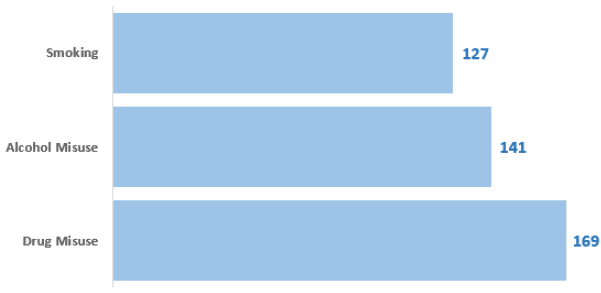
Of the 169 forensic patients that had abused substances (excluding alcohol) in the four weeks prior to admission, 55% had used one substance, while 20% had used two. The most commonly used substance was cannabis, with 63% of forensic patients that had abused substances (excluding alcohol) in the four weeks prior to admission using this substance. The second most common was amphetamine (23%).
Self-harm
Information on self-harm was returned for 401 (84%) of forensic patients. Of these, 67 (17%) had self-harmed in the week prior to admission. This is higher than the 11% reported for all adult patients and is higher than the 15% repored in 2017.
Of those 67 patients, 52 (78%) had self-harmed by non-accidental injury.
Suicidal ideation
Information on suicidal ideation was returned for 424 (89%) of forensic patients. Of these, 19 (4%) had expressed suicial ideation on admission to hospital, the same as 2017. This is lower than the 7% reported in 2016 and lower than the 14% reported for all adult patients.
Contact
Email: Guy McGivern
There is a problem
Thanks for your feedback